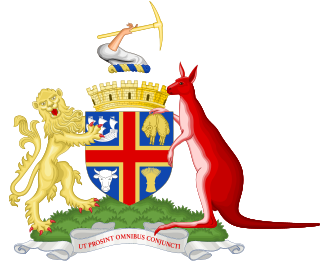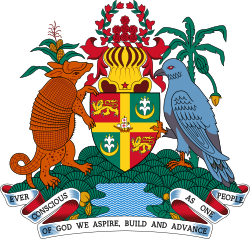
The coat of arms of South Africa is the main heraldic insignia of South Africa. The present coat of arms was introduced on Freedom Day, 27 April 2000, and was designed by Iaan Bekker. It replaced the earlier national arms, which had been in use since 1910. The motto is written in the extinct |Xam, member of the Khoisan languages, and translates literally to "diverse people unite". The previous motto, in Latin, was Ex Unitate Vires, translated as "From unity, strength".

The coat of arms of Prince Edward Island, officially the King's Arms in Right of Prince Edward Island, are the coat of arms of Prince Edward Island, being the arms of King Charles III in right of the province. They were created when the shield and motto in the achievement were granted in 1905 by royal warrant from King Edward VII. The latest iteration was given by the Canadian Heraldic Authority in 2002.

The coat of arms of British Columbia is the heraldic symbol representing the Canadian province of British Columbia. The arms contains symbols reflecting British Columbia's British heritage along with local symbols. At the upper part of the shield is the Union Jack, representing the United Kingdom. The lower portion of the shield features a golden sun setting into the ocean, representing the province's location on the Pacific.

The coat of arms of Ontario is the armorial emblem representing the Canadian province of Ontario. The arms contain symbols reflecting Ontario's British heritage, along with local symbols. At the upper part of the shield is the red cross of St. George, representing England. The lower portion of the shield features three golden maple leaves on a green background.

The coat of arms of Australia, officially called the Commonwealth Coat of Arms, is a formal symbol of the Commonwealth of Australia. It depicts a shield, containing symbols of Australia's six states, and is held up by native Australian animals, the kangaroo and the emu. The seven-pointed Commonwealth Star surmounting the crest also represents the states and territories, while golden wattle, the national floral emblem, appears below the shield.

The coat of arms of Bulgaria consists of a crowned golden lion rampant over a dark red shield; above the shield is the Bulgarian historical crown. The shield is supported by two crowned golden lions rampant; below the shield there is compartment in the shape of oak twigs and white bands with the national motto "Unity makes strength" inscribed on them.

The current coat of arms of Zimbabwe was adopted on 21 September 1981, one year and five months after the national flag was adopted. Previously the coat of arms of Zimbabwe was identical to the former coat of arms of Rhodesia.

The coat of arms of Queensland is one of the formal symbols of the State of Queensland and represents the King's constitutional authority throughout the state. It is the oldest of the state arms of Australia, having been granted in 1893 by Queen Victoria, through the simplest heraldic grants of only the shield of arms, motto, helmet, mantling and crest. In 1977, the red deer and the brolga were assigned as supporters by Queen Elizabeth II during her Silver Jubilee.

The coat of arms of Malta is the national coat of arms of the country of Malta.

The national emblem of Indonesia is called Garuda Pancasila. The main part is the Garuda with a heraldic shield on its chest and a scroll gripped by its legs. The shield's five emblems represent Pancasila, the five principles of Indonesia's national ideology. The Garuda claws gripping a white ribbon scroll inscribed with the national motto Bhinneka Tunggal Ika written in black text, which can be loosely translated as "Unity in Diversity". Garuda Pancasila was designed by Sultan Hamid II from Pontianak, supervised by Sukarno, and was adopted as the national emblem on 11 February 1950.

The coat of arms of New South Wales is the official coat of arms of the Australian state of New South Wales. It was granted by royal warrant of King Edward VII dated 11 October 1906.

The national emblem of East Timor is one of the national symbols of East Timor.

The flag of the governor-general of New Zealand is an official flag of New Zealand and is flown continuously on buildings and other locations when a governor-general is present. The flag in its present form was adopted in 2008 and is a blue field with the shield of the New Zealand coat of arms royally crowned. The official heraldic description is "A flag of a blue field thereon the Arms of New Zealand ensigned by the Royal Crown all proper".

The State Emblem of the Tajik Soviet Socialist Republic was adopted on March 1, 1937 by the government of the Tajik Soviet Socialist Republic. The emblem is based on the State Emblem of the Soviet Union. It shows symbols of agriculture. The red star is prominently featured with a small hammer and sickle within it. The rising sun stands for the future of the Tajik nation, and the star as well as the hammer and sickle for the victory of communism and the "world-wide socialist community of states". The emblem was replaced with the new emblem in 1992, which uses a similar design to the Soviet one. It was, however, was replacing the red banner with the current national flag, the big red star was replaced by the mountains, represents Pamir, the Samanid dynasty crown, and added the Quran book at below. It represents Islam as the official religion.

The Emblem of the Turkmen Soviet Socialist Republic was adopted on 2 March 1937 by the government of the Turkmen Soviet Socialist Republic. The coat of arms is based on the coat of arms of the Soviet Union. It shows symbols of agriculture and heavy industry, as well as a symbol of the Turkmen people, a rug. The rising Sun stands for the future of the Turkmen nation, the red star as well as the hammer and sickle for the victory of Communism and the "world-wide socialist community of states".

The Star of India refers to a group of flags used during the period of the British Raj in the Indian subcontinent. India had a range of flags for different purposes during its existence. The Princely states had their own flags which were to be flown alongside the British flag as a symbol of suzerainty. The official state flag for use on land was the Union Flag of the United Kingdom and it was this flag that was lowered on Independence Day in 1947. The flag of the governor-general of India was defaced with the Star of India. The civil ensign and naval ensign were the Red Ensign or Blue Ensign, respectively, defaced with the Star of India emblem.

The coat of arms of Adelaide was granted by the Herald's College on 20 April 1929.

The heraldic ensigns of the Ministry of Internal Affairs consist of the following elements: large blue shield with a crusader golden eagle, having its head turned to the right, red peak and claws, open wings, holding a silver sword in its right claw; the green olive branch, symbolizing peace and order, replacing the mace from the coat of arms of the country; the small shield, placed on the eagle's chest, having five sectors which symbolize the most important structures of the ministry; at the bottom of the external shield, on a white scarf, the motto of the ministry is written in black: Latin: PRO PATRIA ET ORDINE IURIS, meaning "For the country and for the lawful order". The first sector represents the General Inspectorate of Romanian Police, the second sector includes the heraldic ensigns of the General Inspectorate for Emergency Situations, the third sector contains the ensigns of the General Inspectorate of Border Police, the fourth sector represents the General Inspectorate of Romanian Gendarmerie, the fifth sector represents the Administration, and the sixth sector contains the emblem of the National Archives.

The City of Manchester in North West England has traditionally been represented by various symbols. Most of these symbols are derived from heraldic emblems contained within the city's official heraldic achievement, which was officially adopted when the Borough of Manchester was granted city status in 1842. Notably, the motif of the worker bee has been widely used to represent the city as a symbol of industry.

The coat of arms of McGill University is the official emblem of the university and derives from a heraldic device assumed during the lifetime of the university's founder, James McGill. The first iteration was designed in 1906 by Percy Nobbs, then director of the McGill School of Architecture. The design subsequently varied for decades after until the university's current coat of arms, largely resembling the original design, was finally adopted by the Board of Governors in 1975. Today, the university has approved multiple logos across its faculties and departments, including a separate coat of arms used by the Macdonald Campus.
























